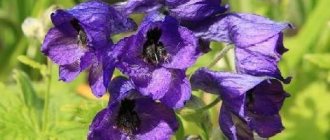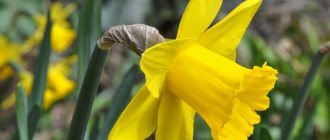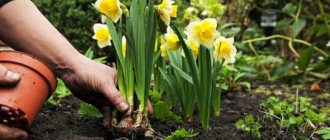The bright and lush flowering of daffodils pleases the eye from early spring. This flower, unpretentious to climatic conditions, is one of the most beloved by gardeners, because in return for its beauty and breathtaking smell, it does not require significant labor or special conditions from a person, but only needs a little care, proper planting and care.
The article reveals the features of the technology for autumn planting daffodils for the winter, describes all its stages, and gives practical advice on choosing a site and preparing the soil. In addition, you will be able to navigate the timing of autumn planting, taking into account the climatic characteristics of the region in which you live.
When to plant daffodils in the ground in the fall
Landing dates
You can dig up daffodils and divide their nests annually, or you can do this once every 3-4 years. These flowers are planted in the fall.
When to plant daffodils in open ground in the fall? In what month should you plant daffodils? On average, the time for planting daffodils is the interval between the second half of August and the second week of September, although in fact the timing of planting daffodils depends on the climatic conditions of the region and the weather, and therefore may shift. The main condition that determines when to plant daffodils before winter is the soil temperature within 8-10 ºC, which lasts for at least two weeks. If planted in a timely manner, the bulbs should have time to form roots before the soil freezes, but at the same time they should not begin to grow.
How to plant lilies in autumn and care after planting
When to plant daffodils in the Moscow region
For example, planting daffodils in the fall in the Moscow region is carried out from August 15 to September 15, since it is at this time in the middle zone that the soil temperature reaches the desired level.
- Poppy: growing from seeds, types and varieties
When to plant in the Leningrad region
At the same time, daffodils are planted in the ground in the Leningrad region, although planting can begin a little earlier - from the second ten days of August. Here again everything depends on when the soil temperature drops to the thermometer mark of 8-10 ºC.
Planting daffodils in autumn in the Urals
Planting daffodils in the fall in the Urals, which one witty gardener called “the land of evergreen tomatoes,” begins in early August. But if the autumn is warm, you can plant the bulbs at the same time as in the middle zone.
When to plant in Siberia
Planting of daffodils and tulips in autumn in Siberia is carried out from August to September, and when exactly to do this, be guided by the soil temperature and the weather forecast.
Choosing a place
Daffodils are not demanding on lighting, so sunny flowerbeds are also suitable for them. and diffuse partial shade next to fruit trees or berry bushes. Since among the varieties of daffodils there are flowers with orange and pink corollas that are prone to fading, this must be taken into account. Transplanting daffodils in the fall will help you better identify places where the sun will quickly burn out the bright colors of the flower. The most shade-loving are jonquillia and taceta-shaped early-flowering varieties.
Flooding areas are also easily identified by autumn, although daffodils tolerate an excess of moisture. It is enough to organize several drainage channels. For such places, late-flowering varieties are chosen. But you should still prefer a gentle slope with a groundwater level below 0.5 m.
The most luxurious ones, whose flowers have an unusual shape or color, are placed in a more visible place, next to ground cover or other spring bulbs. Tubular, terry, large-crowned - they all look great in a rock garden.
Since daffodils do not require annual replanting, it is best not to place them near tulips or hyacinths. It is worth planting daffodils in the fall, when flower beds are being planted for next year, for one more very important reason: daffodil bulbs contain plant poisons that repel pests. Therefore, narcissists often create a kind of barrier. Lushly growing biennials or annuals are planted behind it. They will hide the quickly fading foliage of daffodils and fill the resulting voids.
Planting daffodils before winter
Soil for daffodils
Planting a narcissus in the fall is preceded by choosing a site and preparing the soil, which must be done in the summer. Loams are most suitable for daffodils, although they also grow on other soils. The optimal soil acidity for daffodils is pH 6.5-7.0. On sandy soils, the bulbs gradually become small, and then flowering stops altogether. In addition, sandy soils freeze deeper, which can lead to the death of bulbs in winter. But if the soil in your garden is cultivated, preparing it for planting daffodils is not difficult.
Humus and clay are added to sandy soil, and sand is added to heavy clay soils at the rate of 20 kg per m². Organic matter - humus, compost or rotted manure - is added for digging to a depth of 25-30 cm at least three months before planting, that is, in the spring or early summer. You will need about 15 kg of humus, 20 kg of manure per m². Fresh manure can be applied to the soil no later than a year before planting daffodils.
If you want to dedicate a small area for daffodils, you can simply remove the top layer of soil at this point and replace it with special soil, purchased in a store or made yourself.
- Pumpkin plants: fruit and ornamental
At what depth to plant daffodils?
When you divide a bulbous nest of daffodils, you end up with different sizes of planting material or, as experts say, different varieties. The planting depth is determined by the size of the bulb, being three times its height. That is, above the bulb placed in the ground there should be a layer of soil equal to two times the height of the bulb. For large narcissus bulbs this is 15-20 cm, for small ones - 10-15 cm. However, there are some nuances of immersing the bulbs in the soil that allow you to influence the flowering time and reproduction rate of daffodils.
For example, in order for the narcissus to bloom earlier and its bulb to grow with the maximum number of children, you need to plant the bulb a little smaller than required according to the formula. If you want the flowers to open later and the children to grow less quickly, plant the bulb a little deeper than recommended. For those who are interested in the flowering of daffodils, it is better to plant bulbs of the “extra” class, that is, large ones, and children are more suitable for propagating rare varieties.
How to plant
So, in the spring you have chosen a sunny or semi-shaded area, prepared it for daffodils, and now it’s time to plant them in the ground.
How to plant daffodils? Dig holes according to the size of the bulbs at a distance of 15-20 cm from each other if the planting material is large, and 7-10 cm if you are planting children.
Place a layer of sand in the bottom of each hole, then place the bulbs in them, bottom down, and lightly press them into the sand to make sure there is no void under the bottom. Sprinkle each bulb with wood ash, then fill the hole halfway with soil, and fill the remaining space of the hole with the same soil, but with the addition of complex mineral fertilizer with a predominance of phosphorus and potassium in an amount half as much as prescribed according to the instructions. If the weather is not rainy, water the area thoroughly.
Further care
To prevent the soil from drying out in the fall if it doesn’t rain, daffodils are watered after planting. This can be done until the thermometer drops to 5 - 7 degrees. Further watering causes rotting.
It is important to loosen the soil above the plantings to allow air to flow and remove weeds that take away nutrients. This is done before the first frost, when the weeds die naturally.
In rainy weather, the bed with daffodils is covered with film or agrofibre to reduce humidity, at which the underground part loses the ability to breathe and grow roots.
In spring, ammonium nitrate is scattered on the snow. This fertilizer contains nitrogen, dissolves and penetrates into the soil with melt water, stimulating the growth of bulbs.
It is prohibited to apply fertilizer immediately after planting. Growth stimulants should also not be used, as the bulb will begin to germinate too early and then freeze. If you put fertilizers in the soil when planting, they will last until spring or even next autumn.
Excess moisture has a bad effect on bulbous flowers, so during constant cold rains, cover the bed with film. The film will prevent waterlogging of the soil. If possible, try to loosen the soil at least once a week to allow fresh air to penetrate into the soil, because the tubers need it.
To prevent the germination of bulbs after planting in the event of a weather anomaly, the surface of the flower bed must be mulched with sawdust, peat or leaf litter. It is allowed to use a mixture of the listed components. The thickness of the mulch layer should be 2-5 cm. If sprouts appear in the fall, they will freeze in winter and there will be no spring flowering.
Some gardeners mistakenly believe that after planting, daffodils do not require care, but this is not entirely true. For successful rooting, tubers need moisture. If the autumn turns out to be rainy, watering may not be carried out. In dry weather, it is recommended to water the flower bed within the next 2-3 weeks after planting the planting material; the soil should not look dry.
We suggest you read: When to plant garlic before winter - planting winter garlic
During prolonged rains, it is necessary to build a film shelter over the plantings so that the ground does not turn into a swamp and the bulbs do not rot. If it rains occasionally, the soil needs to be loosened regularly.
Caring for daffodils after planting
Caring for daffodils in autumn
Autumn planting of daffodils is carried out at the end of summer or early autumn, and caring for planting bulbs before the onset of cold weather should serve one purpose - the formation of roots in daffodils. There is no need to fertilize the soil anymore - when preparing the site and planting, you added a sufficient amount of fertilizer.
Watering the daffodils is carried out as the soil dries out, but if it rains, then it’s time to worry about the bulbs not getting wet, so if there is too much rainfall against the backdrop of cold weather, it is better to temporarily cover the area with daffodils with film. In dry autumn, water the daffodils as needed and loosen the soil in the area from time to time to break up the crust that forms on the soil.
Caring for daffodils in winter
Daffodils need shelter in winter, especially in areas where frost is common. At the first frost, carefully loosen the soil in the area with daffodils, and then mulch the surface with a 10-15 cm thick layer of peat, dry leaves, straw, sawdust or wood ash. Or cover the planting with lutrasil or spunbond.
- Brunner: growing from seeds, types and varieties
Benefits of autumn planting
The life cycle of flowers has a short dormant period, so it is better to plant them before the roots begin to actively grow.
If the flowers are planted at the right time, the bulb has time to grow strong roots, and then the plant survives the winter well. Over the winter, the flower gains strength for rapid growth in spring. Attention!
When planting daffodils in the fall, you can create an interesting design for your garden bed. In spring, all that remains is to complement it with other colors.
Transplanting daffodils to another place
The daffodil grows in one place for up to five years, but then its bulb must be removed from the soil, the children separated from it and planted. Sometimes this needs to be done once every five years, and sometimes more often, because the growth and development of plants depends on many factors. However, experts say that it is not worth dividing the onion earlier than after three years. If you notice that your daffodils have grown greatly and have begun to bloom worse, these are sure signs that it is time to replant them.
When to replant daffodils - in spring or autumn? It is more correct to do this after the daffodils have bloomed. But not immediately, but only when the leaves of the flowers turn yellow and fall off, and this happens with daffodils closer to mid-summer.
As soon as the compact daffodil bushes begin to fall apart, remove the bulbs from the ground using a small fork, cut off any remaining stems and leaves and place them in a dark, dry place to dry. When the bulbs are dry, clean the soil from them, carefully separate only those children that easily come off on their own, discard diseased, deformed, soft or diseased bulbs, and rinse the good ones under running water, pickle for 10-15 minutes in a strong solution of potassium permanganate, dark pink and again put to dry in a dry, dark place with a temperature no higher than 25 ºC and good ventilation, then put into storage.
When to replant daffodils in the fall? From August to October. The transplant is carried out in the order we have already described on an area prepared in advance. You also know how to cultivate the soil for daffodils.
Planting in containers
Tubers can not only be planted in open ground, but also grown at home in containers. Take a pot with a diameter of 10-13 cm, make several holes in the bottom so that water can drain. Planting daffodils in containers is carried out in the following way:
- a drainage layer 5-6 cm high is placed on the bottom of the pot, and fertile soil is placed on top of it;
- The tubers are placed on the ground and pressed. One pot contains 3-4 plants;
- Remove the pot with tubers to a dark, cool place with a temperature of 5-8 degrees and leave the bulbs to germinate for 3 months. Plants need to be watered 2 times a month;
- after 3 months, containers with daffodils are placed in a bright, warm room. Increase watering to once a week; you can feed the flowers with nitrogen-potassium fertilizers. Soon the daffodils will bloom. The flowering period can be extended by moving the plants to a cooler room.
You can plant and grow flowers in a container in different ways: at the beginning of winter, at the end of summer. From the moment of planting to blooming, about 2.5-3 months pass.
How to store daffodils before planting in the fall
If you dug up daffodil bulbs in July, but will only need to plant them in the ground in September or even October, the question arises of how and where to store them before planting. And this question can become a problem. The fact is that narcissus bulbs are poisonous - during storage they emit gas, which in a room without ventilation can damage the bulbs themselves. Therefore, put them in a box and keep them somewhere in the garden under a canopy, in the shade.
If for some reason you decide to postpone planting your daffodils until spring, you will have to store the bulbs all winter. It is best to find a place for them in a dark room with a temperature of 10-12 ºC and air humidity within 70%. Place the bulbs on a wooden shelf or in a box in a single layer and try to inspect them weekly for rot or other disease.
If you find white or yellow spots on the bulbs, as well as a foul odor, immediately get rid of such planting material before the infection spreads to neighboring bulbs. Soft bulbs must also be removed.
Detailed article on growing daffodils in the garden
Don't worry about daffodils being damaged by rodents - as already mentioned, they are poisonous flowers and can take care of themselves.
Types of daffodils
Tubular. There is 1 large flower on the stem. The flowers are yellow or white, sometimes bicolor;
Large-crowned. There is 1 flower on the stem. Coloring varies;
Small-crowned. There is also one flower. Has a pleasant persistent smell. Color creamy white;
Terry. This variety has 6 perianth lobes. Flowers can be white or yellow, or bicolor;
Latest articles about gardening
Growing cucumbers in a polycarbonate greenhouse
Growing cucumbers on a windowsill in winter
Growing cucumbers on the balcony starting from seedlings in stages
Cyclamenoides. As a rule, this is a solitary narcissist. Its petals tilt slightly back. The crown is pink-apricot in color, the petals are snow-white;
Jonquilliaceae. It blooms quite late. The leaves are dark green. The crown is red-orange, the perianth is yellow-gold;
Multi-flowered. There can be from 2 to 20 flowers on one peduncle. They have a pleasant aroma. The leaves are dark green. The daffodil itself is yellow, the crown of an unusual shape is orange;
Poetic. There is one delicate white flower on the stem, the crown is bright.
Bulbocodium hybrids. The flowers are bell-shaped. Stem height 10-15 cm.
Split-crown. The crown looks like it has been cut. The crown has a fringed edge and sometimes petals.
Other. Here are collected flowers that are not included in other groups by definition.
Species and hybrid daffodils.
Wild, natural species.











